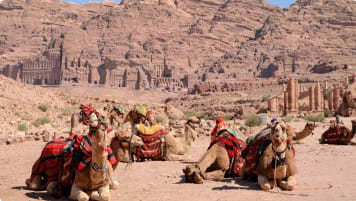Highlights of Jordan | The Jerash Ruins (Gerasa)
Jerash in northern Jordan is noted for its well-preserved Roman ruins, one of the largest in the world.
16 Feb 24 · 8 mins read
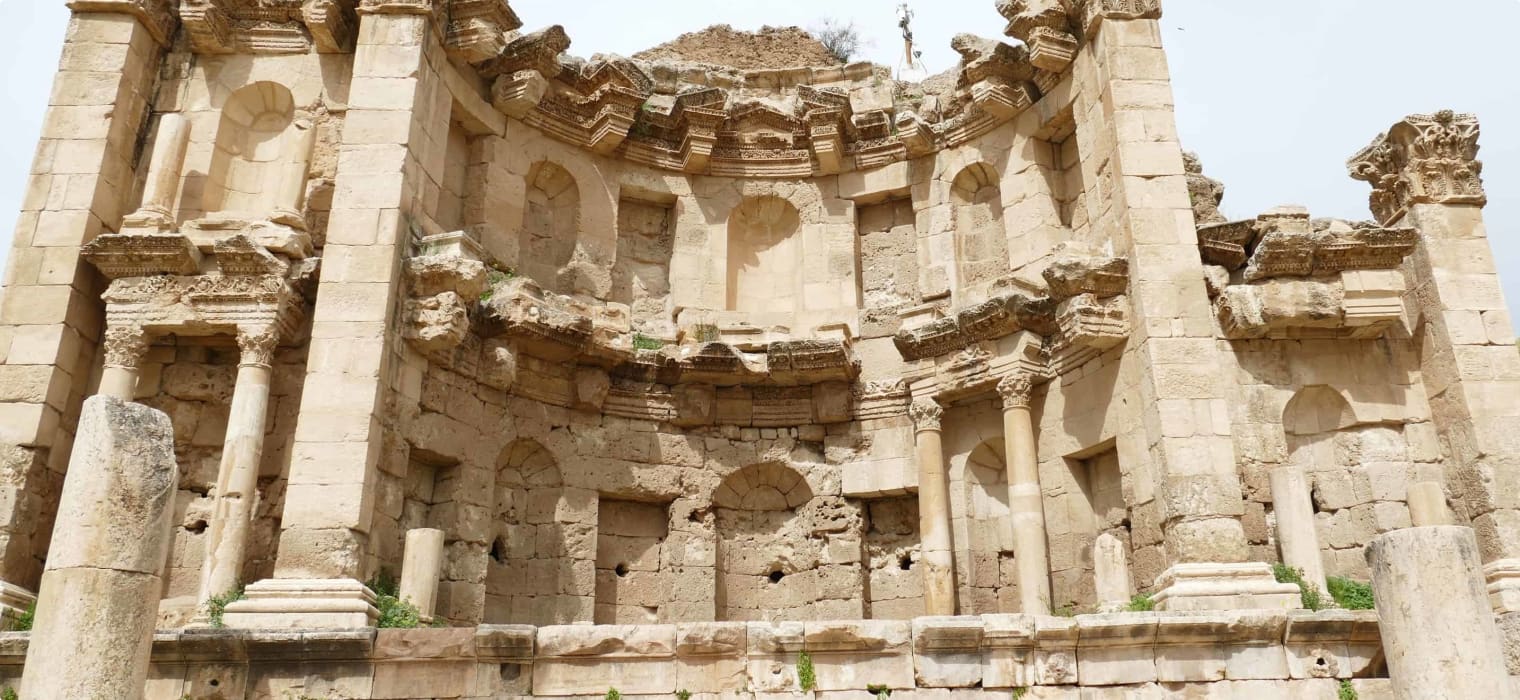
Highlights of Jordan | The Jerash Ruins (Gerasa)
Jerash in northern Jordan is noted for its well-preserved Roman ruins of the ancient city Gerasa, in fact one of the most intact cities of the Greco-Roman era outside of Italy itself. Located 48 kilometres (30 miles) north of the capital, Amman, the Gerasa ruins is one of Jordan’s most popular tourist sites, alongside the ruins of Petra. The archaeological site is a relic of Gerasa’s founding during the Hellenistic period, and its golden age as a prosperous city under the Roman Empire. Currently on the tentative list to be a UNESCO World Heritage Sites, it is considered an ancient meeting place of the East and the West.
This article explores the history and archaeology of the ancient city of Gerasa. It is written as part of Odyssey Traveller’s series on lost ancient cities, with information drawn from Philip Matyszak’s Lost Cities of the Ancient World. The information is intended as background reading for our 9-day Ancient History of Jordan Small Group Tour for mature and senior travellers. During this tour, we conduct a day tour of Gerasa, while exploring Jordan’s most magnificent ancient and natural attractions, from its capital city, Amman Jordan, to the ancient Desert Castles, Petra, the Dead Sea, and more! Read on for more information about Gerasa and the tour!
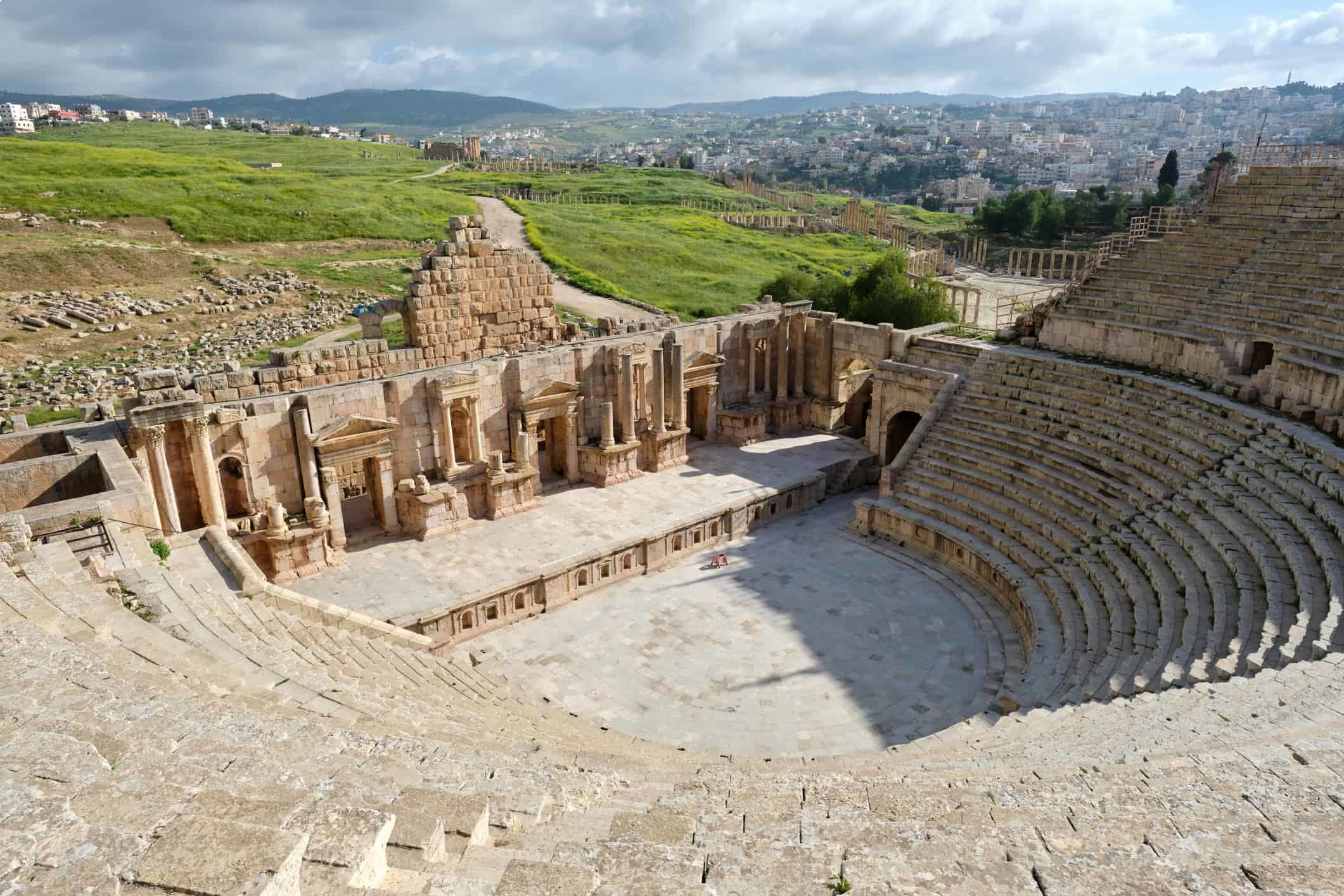
Foundation and Growth of Gerasa
The first settlers made their home at the site of Gerasa some 7,500 years ago. They most likely did so due to the relatively temperate climate which provided, and still provides, good grazing for livestock. Semitic people who worshipped Baal then settled in the area in the 8th century BC, before abandoning it around a hundred years later. From then until around 300 BCE, the site was only visited by nomadic Nabataeans.
It is uncertain when Gerasa formally became a city. It is believed though that, on the orders of Alexander the Great, the location was chosen by the Macedonian general Perdiccas as a place to settle Macedonian mercenaries after Alexander’s successful Egyptian campaign. The city’s name then could came from gerasmenos, Greek for “elderly people”, referring to the veteran soldiers who were said to have been rewarded with a parcel of land in the area.
The city was also known by the Greek name Antiochia ad Chrysorrhoam, “Antioch beside the river of gold”, which points to its roots as a settlement by one of Alexander’s successors, the Seleucid king Antiochus IV Epiphanes, who reigned by 175 to 164 BC. It was under him that the formal settlement of the city probably happened around 170 BCE. The “river of gold” in the city name refers to Chrysoroas, now called Wadi Jerash, a tributary of the Wadi Zarqa.
The Seleucid Empire rose after Alexander’s untimely death at the age of 32, and his empire became divided as his generals began seizing control. His general, Seleucus I Nicator, ruled Alexander’s territories in the eastern regions and began the Seleucid dynasty, spreading Greek customs and culture throughout what we now refer to as the Middle East.
Antiochia ad Chrysorrhoam was blessed with a great location: it had fertile land and stood at the ancient trade route called the King’s Highway, which connected Egypt to Damascus, connecting Jerash to the ports of Tyre, Joppa (modern Jaffa), Damascus, Petra, and the cities of Judaea.

The military colonists of the city were quickly joined by merchants and the city grew wealthy. Seleucid-built temples to Greek gods and goddesses were erected in the city, and trade enabled Jerash to interact with other cultures, leading to ancient Semitic gods also gaining foothold, based on the inscriptions found in the city.
As the Seleucid Empire slumped into decay, the city’s Judaean connection proved crucial. Unwilling to let a vital trade link fall into hostile hands, the Jewish king Alexander Jannaeus (r. 103–76 BC) besieged and captured Gerasa. The city now acquired a large Jewish population, who seem to have lived relatively peacefully alongside the Macedonians as a part of the Hasmonean kingdom.
Gerasa Under Roman Rule
The Roman general Pompey the Great conquered Gerasa in 63 BCE as part of a conflict with the Hasmonean kingdom. Gerasa thus became a Roman city and was later folded into Rome’s new province of Syria. As was the Roman custom, Gerasa was left largely to govern itself, which it did as part of a loose confederation of local cities called the Decapolis.
In Roman times, politics in the Middle East were every bit as turbulent as now, as testified by a comment of the Jewish historian Josephus. A massacre of Jews in the coastal town of Caesarea led to retaliation, in which the Jews ‘separated into various groups and devastated Syrian villages and the nearby cities of Philadelphia Sebonitis and Gerasa’ (Wars of the Jews 2.18.1).
Despite – or because of – this, Gerasa was again in Jewish hands at the start of the anti-Roman rebellion that followed immediately afterwards in 66 CE. When he retook Gerasa, the Roman general Annius followed the tradition described by the historian Tacitus, whereby the Romans ‘create a wasteland and call it peace’ (Agricola 30).
Nevertheless, Gerasa survived the severe depopulation to become a thriving city once more, especially after its incorporation into Emperor Trajan’s new Roman province, Arabia Petraea, in 106 CE. Arabia Patraea was formed as part of a political reorganisation in the region, with the neighbouring Nabataean Empire absorbed into the Roman Empire.
The Nabataean influence can be seen still today in the core of Gerasa, where a temple dedicated to the Nabataean god Pakidas stands. Close by stands the city’s most magnificent temple, that dedicated to Artemis. In addition, the city also boasted a splendid temple to Zeus Olympias and others dedicated to Hera, Apollo, Poseidon, and Nemesis.
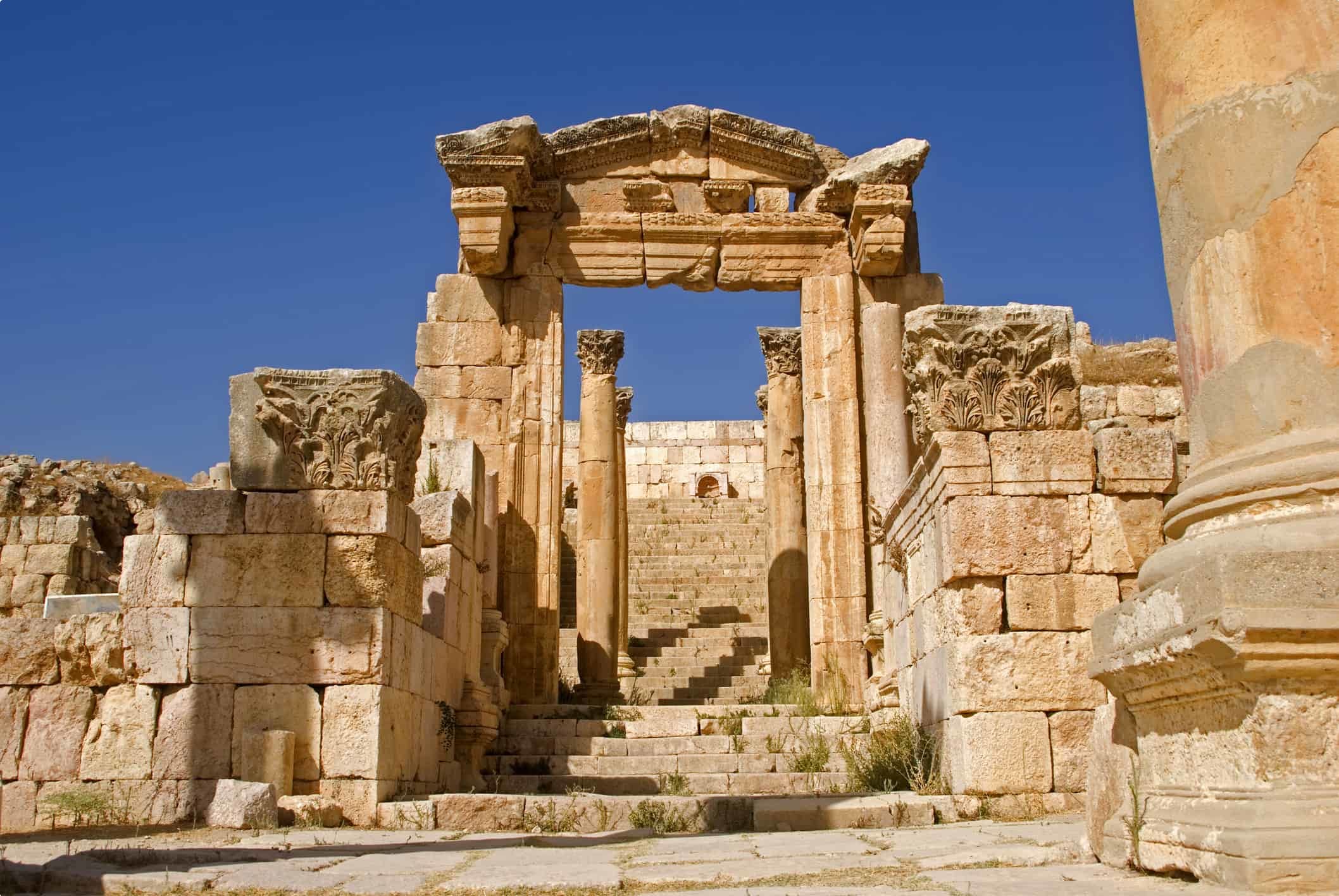
It was during this period that Gerasa entered a period of unprecedented prosperity. It would gain wealth from both its local agricultural and iron-ore mining, as well as its strategic location on the newly paved highway known as Via Nova Traiana (Trajan’s New Road) – the strategic military and trade route linking the eastern and western parts of the Roman Empire. This wealth was reflected in the implementation of a new building plan throughout the 2nd century CE, to which date many of the buildings and structure remaining today.
Later Gerasa
Gerasa began to decline in the 3rd century CE due to the expansion of the Sassanid Persians from the east. There was some economic revival in the area between the 4th and 6th centuries, however, as the Roman Empire fell and survived in the east as the Byzantine Empire. Building continued during this time, most notably the Baths of Flaccu, which were constructed around the 5th century, and Jerash’s Hippodrome, which could fit 15,000 spectators, remained in use for chariot races.
With the Christianisation of the empire, the Byzantine emperors grew the city into a centre of the religion, with fifteen churches built in the urban area. The oldest, the Church of St Theodore, would later become part of the large Gerasa cathedral. Some of the building material for the cathedral was stripped from the temple of Artemis, now deemed surplus to the city’s religious requirements. The cathedral included magnificent mosaic floors, some of which are still very well preserved today.
A Sasanian Persian raid in 614 caused a rapid decline in Gerasa’s wealth and population. Despite its decline, however, the city continued to flourish during the Umayyad period. But while Gerasa seemed able to take all that humanity could throw at it, it was powerless against a massive earthquake that wrecked much of the city in 749. Attempts to rebuild were ruined by further quakes and it seems that for a while the city was abandoned.
Under the Muslim caliphate there was something of a revival. Parts of the city were rebuilt, the local mint started issuing coins, and mosques and churches were in use simultaneously. Sadly, this religious tolerance did not last in the face of religious fanaticism. The Crusaders reached Gerasa in 1121, devastated the city and then promptly abandoned it.
The Jerash Ruins
Though lost and abandoned for centuries, Gerasa gradually revived, and the new Jerash – built alongside rather than on top of the old one – is a regional capital. The relatively good condition of the remains of the Greco-Roman architecture attracts tens of thousands of tourists every year. The site itself is somewhat unsignposted, so visitors must rely on the descriptions provided by the expert guides.
Many of the buildings and structures remaining in Jerash date from the 2nd century AD. Emperor Hadrian wintered in Gerasa in 129 AD, his stay celebrated with the construction of a triumphal arch (Hadrian’s Arch). In 150 AD, the Romans began constructing a temple with Corinthian columns honouring Artemis, the goddess of the hunt and the patron goddess of Gerasa.
The north gate of Gerasa was dedicated to Trajan in 115 CE and was the main entrance gate of the city. Its south theatre was one of the most remarkable in the ancient world, erected during the reign of Emperor Domitian and remodelled by his successors.
Entering from the city’s southern entrance was the Oval Forum (or Oval Plaza). Given the city’s role as a trade centre, this forum was unsurprisingly large – 7,200 square metres (77,500 square feet) – surrounded by imposing columns and paved with limestone slabs. It stood on Gerasa’s colonnaded street Cardo Maximus, or main street. Both are fine examples of the ancient Romans’ careful urban planning.
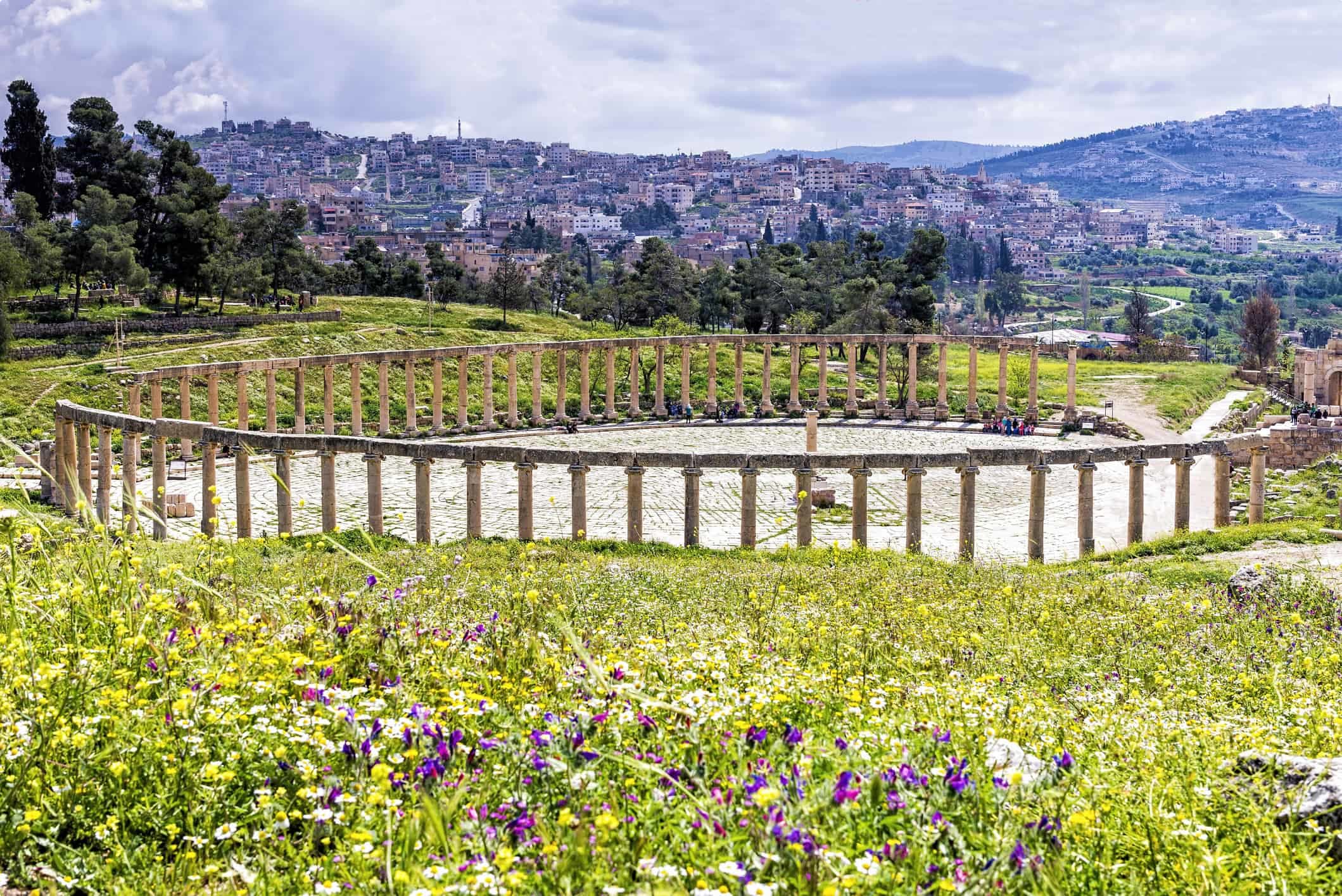
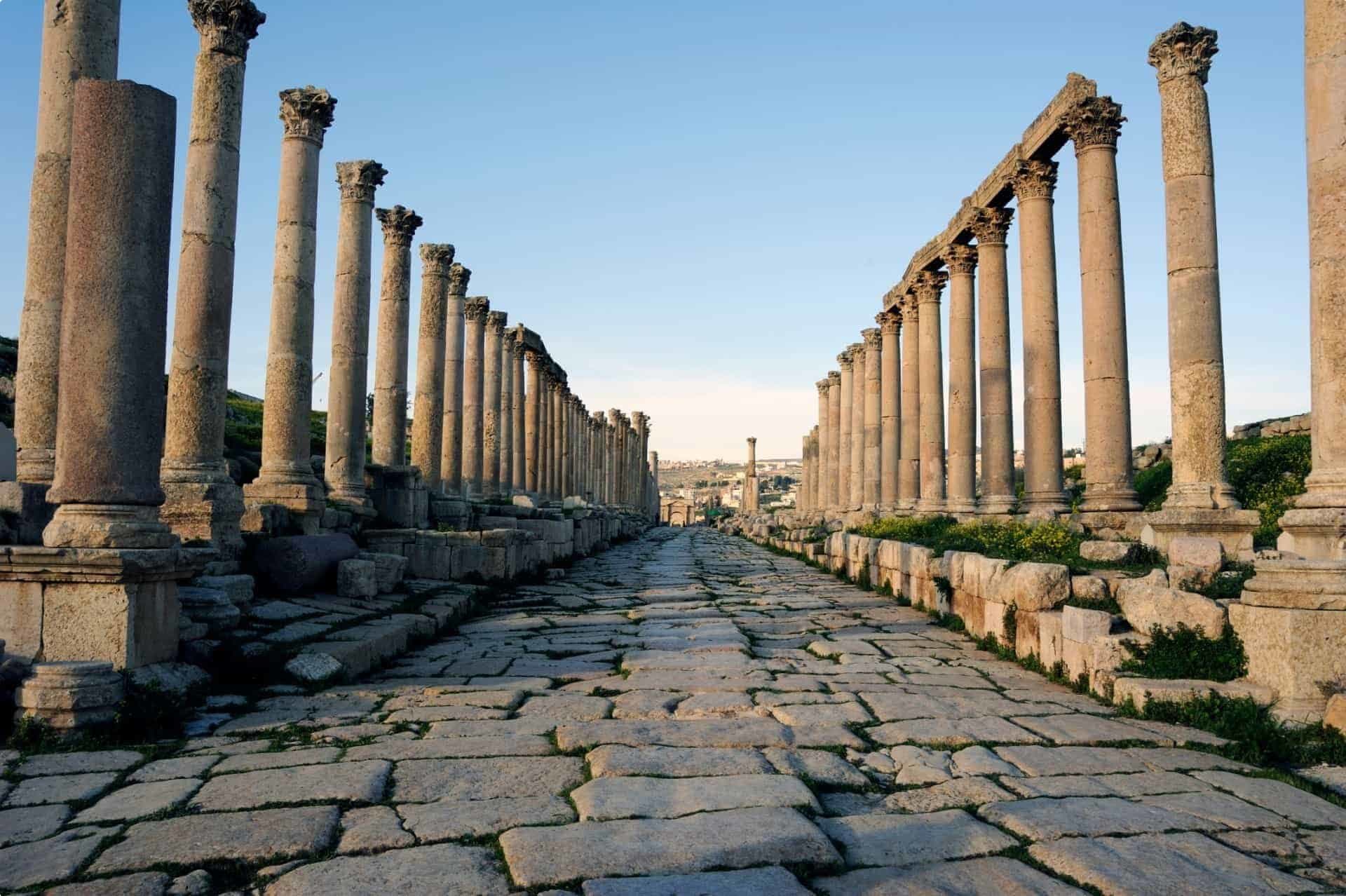
On the western side of the cardo is the Nymphaeum, an elegant ornamental fountain dedicated to the water nymphs.

Today there are also two museums, with the older one displaying many artefacts recovered from the ancient city and the more modern Archaeological Museum documenting the storied history of Gerasa over the last seven millennia.
Tour of Gerasa
Odyssey Traveller takes a day trip to modern Jerash to conduct a tour of the ancient city ruins of Gerasa during our 9-day Ancient History of Jordan Tour. During this escorted small group tour for mature and senior travellers, we also visit the capital Amman, the Dead Sea, the ancient Desert Castles, and the ancient city of Petra. This group tour is ideal for those looking to experience the iconic culture, architecture, and desert landscapes of Jordan.
Arriving in Amman, we will see the Archaeological Museum, the Folklore Museum. We will also visit The Blue Mosque, a spectacular holy structure built in the 17th century. We then travel to Jerash, to take in Gerasa’s visually stunning Roman city walls, paved and colonnaded streets, soaring hilltop temples, theatres, spacious public squares and plazas, baths, and fountains. We also go on to explore Madaba, a city best known for the famous 6th-century mosaic map of Jerusalem & the Holy Land. Madaba is also home to Byzantine and Umayyad mosaics.
Odyssey Traveller has been serving global travellers since 1983 with educational tours of the history, culture, and architecture of our destinations designed for mature and senior travellers. We specialise in offering small group tours partnering with a local tour guide at each destination to provide a relaxed and comfortable pace and atmosphere that sets us apart from larger tour groups. Tours consist of small groups of between 6 and 12 people and are cost inclusive of all entrances, tipping and majority of meals. For more information, click here, and head to this page to make a booking.
Articles about Jordan published by Odyssey Traveller:
- Jordan: A Definitive Guide
- Shobak Castle, Jordan
- Amman, Jordan
- Wadi Rum, Jordan
- Madaba, Jordan
- Touring World Heritage Sites.
For all the articles Odyssey Traveller has published for mature aged and senior travellers, click through on this link.
External articles to assist you on your visit to Jordan:
- Jerash
- Jerash History & Culture (Jordan Tourism Board)
- Rome brought pomp and prosperity to this ancient outpost in Jordan
- Jordan is spectacular, safe, and friendly – so where are the tourists?
- How to be a responsible traveller in Petra.
- How to eat like a true Jordanian.
- The Dead Sea: Why you should visit before it’s too late.
Originally published January 20, 2020.
Updated on February 16, 2024.
Related Tours
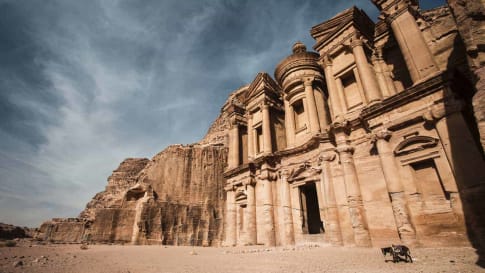
9 days
Jan, OctAncient History of Jordan | Escorted Small Group Tour
Visiting Jordan
Explore Jordan, visiting its capital city, Amman Jordan, the ancient Desert Castles, Petra and the Dead Sea on a small group package tour for mature and senior travellers travelling as a couple or Solo.
From A$6,750 AUD
View Tour


